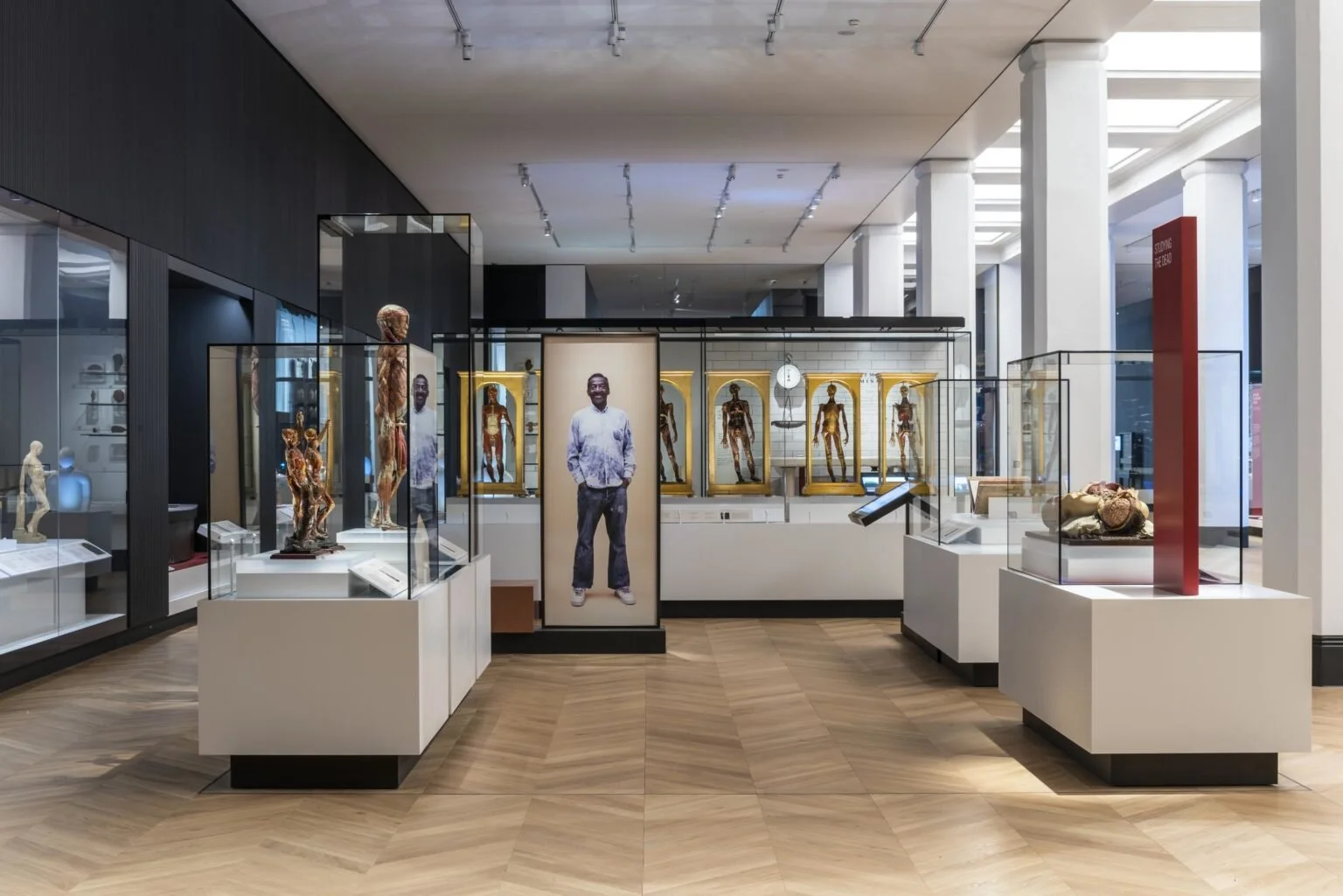Portrait Series for the Medicine Galleries
Medicine and Bodies gallery, part of Medicine: The Wellcome Galleries at the Science Museum © The Board of Trustees of the Science Museum
Cross-posted from the Science Museum Group Blog, as part of a series called ‘Open for All’ discussing the work we’re doing to make the museums truly inclusive.
—
Within Medicine: The Wellcome Galleries at the Science Museum, visitors encounter a series of portraits by award-winning photographer Siân Davey. The portraits form part of a series of artworks commissioned for the galleries, which opened in November 2019.
Alongside Davey’s portraits, artworks on display include beautiful bronze sculptures by Eleanor Crook and Marc Quinn, and a thought-provoking installation by Studio Roso.
Together they act as powerful visual interventions into the galleries’ themes and give visitors a different way to connect with the objects and stories on display.
Many of the objects and topics in the galleries present a medicalised perspective on bodies and health. In recognition of this, the museum developed When medicine defines what’s ‘normal’, a project to explore what it means to people when their bodies ‘fall outside the norm’.
Through portraits and recorded interviews with 16 participants, the project aims to represent diverse experiences of people living today.
The team researched photographers who might suit this portrait project and were immediately struck by the work of Siân Davey. Following a 15-year career as a psychotherapist in private practice, Davey launched a second career in photography in 2014.
Her work draws on her experiences as a psychotherapist and mother, with family and community providing central themes to her work. Her portraits are frank, beautiful and empathetic, and she is a moving advocate for the importance of interrogating how we consider difference within our society.
We were delighted when she agreed to take on this commission.
Davey and her team worked with the Science Museum and members of the When medicine defines what’s ‘normal’ participation group to discuss how her portraits could communicate a vivid sense of each sitter’s personality and varied life beyond their experience of a medical condition.
To aid this, Davey produced two portraits of most sitters, in some cases including a family member, with different poses and accessories.
The group discussed image composition, clothing choices, accessories and background colour palette with Davey, to reach a brief for the portraits that would give them real power and presence in the galleries.
The photo shoots took place in a studio in South London over July and August 2018, and the Science Museum team were fortunate to spend time with the sitters and Davey, seeing how each portrait was built out of a relationship.
Each sitter was given the opportunity to spend time with a professional hair and make-up artist and to discuss their clothing choice with Davey, in order to present themselves in the way they wanted in their portrait.
They then spent time discussing poses, getting comfortable in the space and in front of the coloured backdrop, chatting as Davey began to take photographs.
Separate audio interviews were undertaken by the museum with each sitter, to enable them to relate their own stories on recordings in the galleries.
The individuals featured range from Gifford who speaks about his experiences of mental health issues, to Jamie who talks about how having a physical disability has been both significant and insignificant in shaping his identity.
We meet Sharon who lives with the unpredictability of ME, mother and daughter Alice and Molly who discuss the impact of Alice’s stroke on their family life, and mother and son, Ruth and James who are living with James’s sickle cell anaemia.
Each sitter worked with Davey to capture their experiences and the resulting images provide a personal, human context to the medical innovations displayed in the Medicine and Bodies gallery.
As a whole, the portraits question medical definitions of what a supposedly ‘normal’ human body is and the ways in which identities are shaped by medical intervention.
Through Davey’s photographs the galleries reflect a variety of personal perspectives that provide unique and surprising insights, helping to challenge stigma associated with difference and provoke reflection on the objects displayed within the gallery, and the practice of medicine itself.
They show that everyone has a medical story.
Davey was also commissioned to capture portraits of individuals who either receive or give medical care for the Medicine and Treatments gallery.
This gallery examines the medical challenges of living in an increasingly urbanised world, the impact of infectious diseases and how our behaviour can affect our health.
In Medicine and Treatments, Davey’s portraits illuminate the human side of treatment and illness, highlighting the universal impact of medicine in all our lives. Again, each sitter features in two varied portraits, with poses and background colours informed by the conventions for When medicine defines what’s ‘normal’.
They are displayed alongside objects and quotations relaying their experiences. Isabella Jenkins inspired Team UnLimbited to produce a 3D printed arm, an example of which she wears in one portrait. Their first design is the ‘Isabella’.
Paul Monks is an artist and founder of Core Arts, which works with mental health services. He has donated a painting to sit alongside his portrait in the gallery.
Davey also worked with photographer Chirag Parmar to capture portraits of Samson Akichem Lokele, who is an eye doctor working with Sightsavers in Kenya and Uganda.
Davey’s portraits bring 22 individuals (including 16 from the participatory project) into the museum, not only as specially-produced physical and digital portraits for Medicine: The Wellcome Galleries but also in the Science Museum Group Collection, where archival photographic prints are being added to the national collection (which will last beyond the 25-year lifespan of the galleries).
Her work is crucial in capturing more diverse and inclusive narratives that help to tell the story of medicine and highlights the ability of art to make the abstract feel deeply personal.
